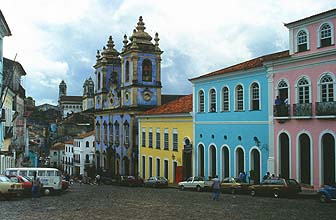|


| |

Salvador,(pop. 2,300,000), Brazil's former colonial capital, (pop. 2,300,000),
lies on the Bay of All Saints (Bahia de Todos os Santos), the second largest bay
in the country. The strong African influence found here derives from the slaves
brought to work in the sugarcane fields more than 400 years ago. Salvador is
divided into an Upper Town and a Lower Town. Both are linked by the art-deco
Lacerda elevator, which offers outstanding views. The Pelourinho is the largest
intact colonial center in the Americas. Its twisting, narrow cobblestone streets
are lined with pastel mansions and stunning baroque churches and convents.
Colorful open-air markets, an amazing array of popular and religious festivals
(including Afro-Brazilian Candomble ceremonies and fantastic beaches) make this
an excellent place to stay for two or three nights.
No tour of the city is complete without seeing the Igreja de Sao Francisco -
although relatively plain on the outside (as are most Portuguese churches in
Brazil), the inside is covered in gold leaf and is as ornate as it is beautiful.
Also visit the Farol da Barra, a 16th-century fortified lighthouse that
overlooks the Bay of All Saints and the island of Itaparica. The Igreja do
Bonfim is where believers from the northeast go to worship and pay for the
promises they made in return for miracles (don't miss the Room of Miracles,
where pilgrims leave wooden, silver or wax replicas of body parts in need of
miraculous healing - you'll be amazed by the number of arms, legs, heads, hearts
and lungs dangling from the ceiling). Dozens of other stunning colonial churches
are sprinkled throughout Salvador's center and colonial district, including the
Cathedral Igreja Nossa Senhora Rosario dos Pretos (built by and for slaves),
Igreja deo Carmo and Igreja Nossa Senhora da Conceicao.
Shopping is good at boutiques in the neighborhoods of Barra and in the
Pelourinho, as well as at shopping malls such as Barra and Igautemi. Avoid the
touristy Mercado Modelo. The chaotic but colorful Sao Joaquim market has
interesting and authentic Afro-Brazilian artifacts.
A look into the city's past can be seen at the Museu de Arte da Bahia
(17th-century antique displays) and the Museu de Arte Sacra. The city's culture
is celebrated in the Museu da Cidade (Yoruba tribal displays), the
Afro-Brazilian Museum (with good explanations about Afro-Brazilian religions)
and the sumptuously furnished Carlos Costa Pinto Museum, located in a
19th-century mansion. Try to attend a candomble religious ceremony at a
traditional house or terreiro, and watch capoeira, an amazing
combination of martial arts and African folk dance (don't take pictures of the
participants unless you are willing to pay for the privilege). Salvador also has
a great Carnival celebration. Billed as the largest street party in the world,
it is seven days of nonstop revelry that in recent years has threatened to
eclipse even Rio's Carnival.
|